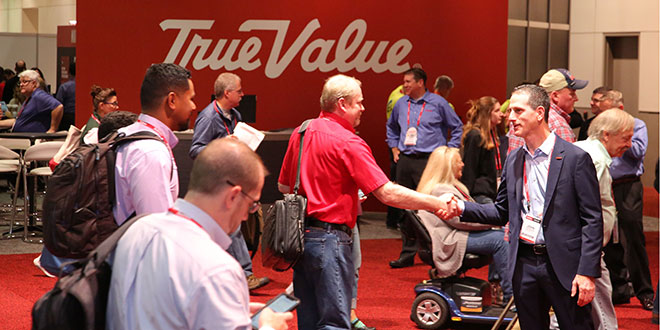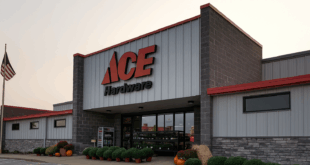During the True Value 2019 Fall Reunion, president and CEO John Hartmann took time to speak to Hardware Retailing about how the company’s new supply chain upgrades, digital marketing programs and other new initiatives will empower the retailers who choose True Value.
For a complete summary of the 2019 Fall Reunion, read Hardware Retailing’s report from the show floor.
Hardware Retailing (HR): True Value will soon open its new regional distribution center (RDC) in Wilkes-Barre, Pennsylvania. Why was investing in supply chain upgrades important for True Value?
John Hartmann (JH): We are a product-based wholesale distribution company and distribution is the heart and lungs of what we do. Obviously, we create great assortments on the front end by working with our vendor partners to craft Customized True Blue assortments, which are individually made to suit individual marketplaces.
We needed a very efficient distribution network to bring all those products to our independent hardware retailers. Investing in the supply chain supports that wholesale distribution model and fulfills the need to get products quickly and efficiently at very high fill rates to our customers.
The northeast corridor is very important to us. We’ve had an RDC in Allentown, Pennsylvania, for many years, but it’s an aging facility. It was time for a brand new, modern distribution center right smack in the middle of the northeast. It will be up and running soon and bring more than 200 new jobs to the area.
HR: True Value has an existing hub-and-spoke supply chain in the Midwest, and the Wilkes-Barre RDC will serve the northeast corridor. Are there plans to expand hub-and-spoke distribution across the country?
JH: Yes. We tested and piloted the hub-and-spoke model in the Midwest with Harvard, Illinois, being the hub and Mankato, Minnesota, and Kansas City, Missouri, being the two spokes. We went live with that last year and it’s working really well.
What we saw in the initial phase really proved our theory that we could move the most important SKUs closest to our customers in one of the spokes or at the hub, and then manage our inventory to improve fill rates for our customers and leverage our assets the best we could from an investment standpoint.
We saw our fill rates, which were already industry-leading at around 97.5 percent, rise to just over 99 percent first-time fill rates. We’re very pleased with that.
Our plans are to do the same things we’ve done in the Midwest: test and ensure we have it completely right without interrupting any service levels to our customers and ensuring we see the same high fill rates. Having higher fill rates is a differentiator for us from our competition. Once we get this brand new facility up to its full potential volume, then we’ll look to the rest of the country.
HR: At the General Session, retailers heard updates on new marketing programs, including the possibility to customize digital ads to be hyper-local. Why is it important for retailers to embrace digital advertising?
JH: It’s important for retailers to embrace digital advertising right now because that’s how many consumers are getting information on what to buy. Particularly through the True Value Rewards program, we see consumers’ behavior when they see a digital ad and we can tell when they’ve purchased something in the store. Currently, about 50 percent of True Value customers who research something online then make a purchase in a True Value store.
What’s important to True Value is that we’re supporting our retailers’ investment in marketing. They have a precious marketing budget and it should be spent on customers who are actually seeing their advertising. That’s the variable that’s important about digital: You’re ensuring a significantly higher percentage of people who actually view your advertising are going to walk into your store and buy something.
By providing our stores with the technology to show their inventory, their local pricing and sell out of their stock, that eliminates the situation where someone makes an online order and has it shipped to the store, but the store already had that product in stock. It allows retailers to sell out of their own inventory.
We took all our customers who participate in print, digital and both forms and then did the math. We provided the data to our customers on how many dollars in sales were returned for each dollar they invested in those buckets and the best was a mix of print and digital. The best of the best was a mix of print and digital along with the True Value Rewards program. It’s just proven to drive higher sales with repeat customers.
HR: In 2018, True Value shareholders voted to proceed with the strategic investment from ACON Investments. Does that decision still affect your company’s operations?
JH: It’s totally rearview mirror. We disrupted the channel. Our board of directors purposefully set out to change the business model in a way they thought would be more beneficial to independent hardware retailers.
We were a co-op for about 70 years. We changed the structure of the business. Our competitors tried to say ‘big, bad private equity’ would drive changes different from what True Value leadership wants. But now we can fast-forward a year and a half and hear from members and customers who say their day to day with True Value has only gotten better.
We returned a substantial amount of money to independently owned hardware store owners. They retained some ownership in the company, and we’ve kept all the commitments we made to them.
We’re also making major investments in product, supply chain, marketing, technology and many other areas. We’re making these massive investments without burdening them with the financial responsibility. We’re responsible for those investments, it’s not coming out of their pockets.
HR: There were thousands of True Value retailers at this year’s Reunion, but if a retailer couldn’t make it to Chicago, what would you want them to know about the 2019 Fall Reunion?
JH: The theme of our General Session was ‘Built for This,’ and it reflects the proud heritage of True Value, the philosophy of our company to support independent hardware retailers and that they are, day in and day out, built for what they do in their communities.
I showed pictures of my dozens of visits to stores across the country, but the pictures are less important than the conversations I had with our customers. Their feedback, their advice, the stories they tell me about what they need to continue to grow and become more profitable are a direct influence on our decisions to innovate in marketing, add new product categories, invest in new distribution capabilities, improve upon great fill rates and ensure we’re super competitively priced on the products that matter most to them. We’re built for supporting independent retailers.
 Hardware Retailing The Industry's Source for Insights and Information
Hardware Retailing The Industry's Source for Insights and Information







